GPS Tool Box
The GPS Easy Suite–Matlab code
for the GPS newcomer
Kai Borre
Abstract The Matlab computing environment has
become a popular way to perform complex matrix
calculations, and to produce sophisticated graphics
output in a relatively easy manner. Large collections
of Matlab scripts are now available for a wide variety
of applications and are often used for university
courses. The GPS Easy Suite is a collection of ten
Matlab scripts, or M-files, which can be used by
those just beginning to learn about GPS. The first
few scripts perform basic GPS calculations such as
converting GPS Time in year/month/day/hour/
minute/second format to GPS week/seconds of week,
computing the position of a satellite using a
broadcast ephemeris, and computing the
coordinates of a single point using pseudorange
observations. The latter scripts can perform
calculations such as computing baseline components
using either traditional least-squares or a Kalman
filter, fixing cycle slips and millisecond clock jumps,
and computing ionospheric delay using carrier
phase observations. I describe the purpose of each
M-file and give graphical results based on real data.
The Matlab code and the sample datasets are
available from my website. I have also included
additional text files (in pdf format) to discuss the
various Time Systems and Coordinate Systems used
in GPS computations, and to show the equations
used for computing the position of a satellite using
the ephemeris information broadcast from the
satellites.
Received: 8 January 2003 / Accepted: 24 January 2003
Published online: 4 April 2003
ª Springer-Verlag 2003
K. Borre
Danish GPS Center, Aalborg University,
Niels Jernes Vej 14, 9220 Aalborg, Denmark
E-mail: borre@gps.auc.dk
Tel.: +45-9635-8362
Fax: +45-9815-1583
Introduction
I seldom teach the same course the same way. Often I start
afresh. Last autumn I tried a new approach to lecturing my
Introductory GPS Computations class. Courses in my de-
partment run in modules of six lectures; so I split up the
basic issues into six lectures containing the following
topics:
– time: Universal Time, GPS Time (GPS week and seconds
of week), Modified Julian Date, Leap Seconds, Interna-
tional Atomic Time, Terrestrial Dynamical Time (see
time_itr.pdf on the web at http://www.gps.auc.dk/
~borre/easy;
– Kepler’s laws, computation of satellite position (see
Strang and Borre 1997, pages 482–487);
– observation types, computation of receiver position (see
Strang and Borre 1997, pages 463–465, 460–461);
– observational errors, differencing techniques, Dilution
of Precision (DOP) (see Strang and Borre 1997, pages
453–460, 462–463, 465–467);
– computation of a baseline from pseudoranges;
– computation of a baseline from pseudoranges and phase
observations (see Strang and Borre 1997, page 463).
Some reflections resulted in four additional topics:
– estimation of the receiver clock offset (see Strang and
Borre 1997, pages 507–509);
– cycle-slip detection and repair of millisecond receiver
clock resets (see Strang and Borre 1997, pages 491, 509);
– various representations of an estimated baseline (see
Strang and Borre 1997, pages 367–368, 472–475,
501–502);
– ionospheric delay estimated from carrier phase
observations F1 and F2 (see Strang and Borre 1997,
page 490).
The basic GPS datasets we will be working with were
collected at Aalborg by two JPS Eurocard receivers on 4
September 2001. The resulting Receiver Independent
Exchange (RINEX) files (Gurtner 2000) are site247j.01o,
site24~1.01o, and site247j.01n. For the more specialized
topics we need a longer observation series; this is
contained in file kofi1.01o.
We number the Matlab scripts easy1 to easy10; hence, they
more or less relate to the ten topics listed above. All files
are zipped and are available via the world wide web at
http://www.gps.auc.dk/~borre/easy.
DOI 10.1007/s10291-003-0049-3
GPS Solutions (2003) 7:47–51
47
�
GPS Tool Box
Much of the theoretical background for the easy scripts
can be found in chapters 14 and 15 of Strang and Borre
(1997). However, we wanted to add some additional text
here to emphasize certain issues which are central to the
code but often are not mentioned in textbooks. Below
follows a description of the various M-scripts.
The Easy Suite
easy1
Nearly any GPS processing starts with time issues. Easy1
shows how to convert a given epoch, originating from one
of the RINEX Observation files (O-files), to GPS week and
seconds of week (sow). We include the time_itr.pdf file
which is a text file which gives an overview of relevant
timescales and reference frames useful for GPS.
easy2
The second basic computation is to calculate the position
in the Earth-Centered, Earth-Fixed frame (ECEF) of a
given PRN at a given time. For a given time and an
ephemeris obtained from a RINEX Navigation Message file
(N-file), easy2 does the job. The main function is satpos
which is an implementation of the procedure described in
the GPS Interface Control Document (ICD-GPS-200C
1997), Table 20-IV. We read a RINEX N-file and reformat
it into Matlab’s internal format, namely, a matrix named
Eph. Furthermore, we relate each PRN to a column of Eph.
Each column contains 21 variables; these comprise a
complete ephemeris for one satellite.
easy3
In easy3 we compute a receiver’s ECEF position from
RINEX O- and N-files. Only pseudoranges are used. The
computation is repeated over 20 epochs. Each position is
the result of an iterative least-squares procedure. The
variation of the position relative to the first epoch is shown
in Fig. 1. The variation in coordinate values is typically
less than 5 m. We open a RINEX O-file and read all the
pseudoranges given at an epoch. With given satellite
positions from easy2, we compute the receiver position.
Fig. 1
Change in position over time using pseudoranges
Fig. 2
Change in baseline components over time using pseudoranges
easy4
The easy4 file deals with simultaneous observations of C/A
pseudoranges from two receivers. We estimate the baseline
between the two antennas and plot the baseline compo-
nents in Fig. 2. We obtain variations in the components of
up to 10 m. So, an antenna point position and a baseline,
both estimated from pseudoranges alone, do have the
same noise level. This statement is valid only for
observations taken after 2 May 2000.
easy5
So far all computations have been based on pseudoranges
alone. Easy5 now includes phase observations as well.
Apart from some more bookkeeping and the problem of
ambiguity fixing, we do the same processing. For fixing the
phase ambiguities we use the Lambda method; it has a
Matlab implementation which we exploit through the call
lambda2. With fixed ambiguities, we compute the baseline
as a least-squares solution epoch by epoch. From Fig. 3 we
immediately have the nice feature that the variation of the
baseline components is now at the 10-mm level. That is,
our results improve by a factor of 1,000 by including phase
observations.
easy6
We now want to use a Kalman filter instead of a least-
squares solution for the baseline estimation. We use an
extended Kalman filter and we quote below the core lines
of code. In filter terminology ‘‘extended’’ means nothing
else but nonlinear.
Any Kalman filter needs initialization of three different
covariance matrices: the covariance matrix P for the state
48
GPS Solutions (2003) 7:47–51
�
GPS Tool Box
Fig. 3
Baseline components over time using pseudorange and phase
observations
vector x (the vector of unknowns), the covariance matrix Q
for the system, and the covariance matrix R for the
observations. A Sigma matrix takes care of the correlation
of the observations introduced by using the double
differencing technique.
– % The state vector contains (x,y,z)
– % Setting covariances for the Kalman filter
– P=eye(3); % covariances of state vector
– Q=0.05^2*eye(3); % covariances of system
– R=0.005^2*kron(eye(2),inv(Sigma)); % covariances of
observations
The extended Kalman filter is implemented as four lines of
code. Let the coefficient matrix of the linearized observa-
tion equations be A, and the right side is the observed
minus computed values of the observations, b)bk:
– P=P+Q;
– K=P*A¢*inv(A*P*A¢+R);
– x=x+K*(b)bk);
– P=(eye(3))K*A)*P.
The output for each epoch (update) is the state vector x
(baseline) and the updated covariance matrix P for x. Note
that there is no term like Ax because the innovation is
b)bk rather than b)Ax.
easy6e
Easy6e is the same as easy6 except here the Kalman filter
uses an overweighting of the most recent data. This
method is also called exponentially weighted recursive
least squares (Kailath et al. 2000).
We introduce a known scalar s such that 0
GPS Tool Box
Fig. 5
Receiver clock offset dt
Fig. 6
Check of cycle slips
amount of receiver clock is typically one millisecond, and
it influences the pseudoranges alone, while cycle slips spoil
the carrier phase observations.
The preliminary data validation can be based on the single
differenced observations (i.e., differences between two
receivers). The goal is to detect cycle slips and outliers in
the GPS single difference observations without using any
external information with regard to satellite and receiver
dynamics, their clock behavior and atmospheric effects. It
is done independently for each satellite. There is therefore
no minimum number of satellites required for this so-
called integrity monitoring to work. The following is based
on an idea by Kees de Jong (de Jong 1998).
The dual-frequency single difference measurement model
cannot be used directly as it is, since this model is
50
GPS Solutions (2003) 7:47–51
singular. In order to make it regular, a re-parameteriza-
tion has to be performed. Let a=(f1/f2)2, and let hardware
delays be denoted g, then the measurement model for
3
2
2
epoch k reads
6664
6664
7775 q þ c � dt þ T þ I þ gP1
3
7775
¼
1
1
½
k
P1
P2
U1
U2
1
2
1
6664
k
þ
3
7775
ð1Þ
0
ÞIk
gP2 � gP1 þ a � 1
gU1 � gP1 � 2Ik þ k1N1
ð
gU2 � gP1 þ �a � 1
ð
ÞIk þ k2N2
where P1 and P2 are the pseudorange observables, F1 and
F2 are the carrier phase observables, N1 and N2 are the
carrier phase ambiguities, k1 and k2 are the wavelengths
associated with frequencies f1 and f2, q is the geometric
range, dt is the receiver clock oset, T is the tropospheric
delay, and I is the ionospheric delay (all terms are single-
dierenced quantities in units of meters). In abbreviated
2
notation this gives
664
3
2
775 B1
4
3
775
2
664
3
775
2
664
3
5
¼
Rk þ
ð2Þ
0
a � 1
0
0
0
0
0
0
0
�2
0 �a � 1
P1
P2
U1
U2
1
1
1
1
B2
B3
with covariance matrix Sb=2S and
k
2
664
r2
P1
0
0
0
R ¼
3
775
0
r2
P2
0
0
0
0
r2
U1
0
0
0
0
r2
U2
k
½
Rk ¼ q þ c � dt þ T þ I þ gP1
B1 ¼ Ik � gP1 � gP2
a � 1
B2 ¼ Ik þ gP1 � gU1
B3 ¼ Ik þ gP1 � gU2
a þ 1
� k1N1
2
� k2N2
a þ 1
2
k
ð3Þ
ð4Þ
ð5Þ
ð6Þ
ð7Þ
3
5
2
4
Parameter Rk in general does not change smoothly with
time and is therefore hard to model using, for example,
low-degree polynomials. It will therefore be eliminated by
pre-multiplying the left and right sides of the above
measurement model by the transformation matrix M,
defined as
�1
�1
�1
3
2
resulting in
P2 � P1
4
5
U1 � P1
U2 � P1
0
�2
0 �a � 1
2
3
4
5 B1
B2
B3
a � 1
0
0
0
1
0
2
4
M ¼
3
5
ð9Þ
ð8Þ
1
0
0
0
0
1
¼
0
0
k
k
�
GPS Tool Box
with covariance matrix M Sb MT. The parameters B1, B2,
and B3 are linear combinations of the time-dependent
ionospheric eect and the constant hardware delays and
carrier ambiguities. The ionospheric eect will be modeled
as a first-order polynomial, i.e., as a bias Ik and a drift _IIk.
� �
� �
The dynamic model reads
I
I
_II
_II
tk � tk�1
ð10Þ
�
1
k�1
2
The dynamic model for all parameters then becomes
664
3
2
775 B1
664
3
775
3
775
ð11Þ
tk � tk�1
tk � tk�1
tk � tk�1
1
0
0
1
0
B2
B3
_II
k
�
¼ 1
0
2
664
¼
k
B1
B2
B3
_II
1
0
0
0
3
5
0
1
0
0
2
4
2
and the measurement model becomes
4
P2 � P1
U1 � P1
U2 � P1
¼
k
a � 1
0
0
0
0
0
�2
0 �a � 1
k�1
2
3
664
5 B1
B2
B3
_II
0
0
0
3
775
k
ð12Þ
:
Fig. 7
Ionospheric delay as a function of time
With the above measurement model and dynamic model,
it is possible to detect cycle slips as small as one cycle in
the carrier observations, without using any external in-
formation, even for relatively large observation intervals
(or data gaps) tk–tk)1.
easy9
This script converts the estimated baseline to topocentric
geodetic azimuth, elevation angle and slant distance, and
applies covariance propagation. The input of the covari-
ance propagation is the 3·3 covariance matrix obtained
from the baseline estimation.
easy10
�
If we use a dual-frequency receiver we can estimate the
ionospheric delay Ik at epoch k as
Ik ¼ a U2;k � U1;k
� a k2N2 � k1N1
Þ:
�
ð
ð13Þ
We are only interested in changes of Ik over time for the
individual PRNs, so we may omit the last, constant term.
This leaves the simple expression for the ionospheric delay
Ik ¼ a U2;k � U1;k
ð14Þ
�
�
:
Estimates of Ik for the various PRNs are shown in Fig. 7.
The data are from file kofi1.01o.
References
de Jong K (1998) Real-time integrity monitoring, ambiguity
resolution and kinematic positioning with GPS. In: Proc 2nd
European Symp GNSS’98, Toulouse, pp VIII07/1–VIII07/7
Gurtner W (2000) RINEX: the receiver independent exchange
format version 2.10. Available from ftp://igscb.jpl.nasa.gov/
igscb/data/format/rinex210.txt
ICD-GPS-200C (1997) Interface control document, IRN-200C-002,
25 September 1997. ARINC Research Corporation, Fountain
Valley, CA
Kailath T, Sayed A, Hassibi B (2000) Linear estimation. Prentice
Hall, Englewood Cliffs, NJ
Strang G, Borre K (1997) Linear algebra, geodesy, and GPS.
Wellesley-Cambridge Press, Wellesley, MA. Order at
www.wellesleycambridge.com
GPS Solutions (2003) 7:47–51
51
�
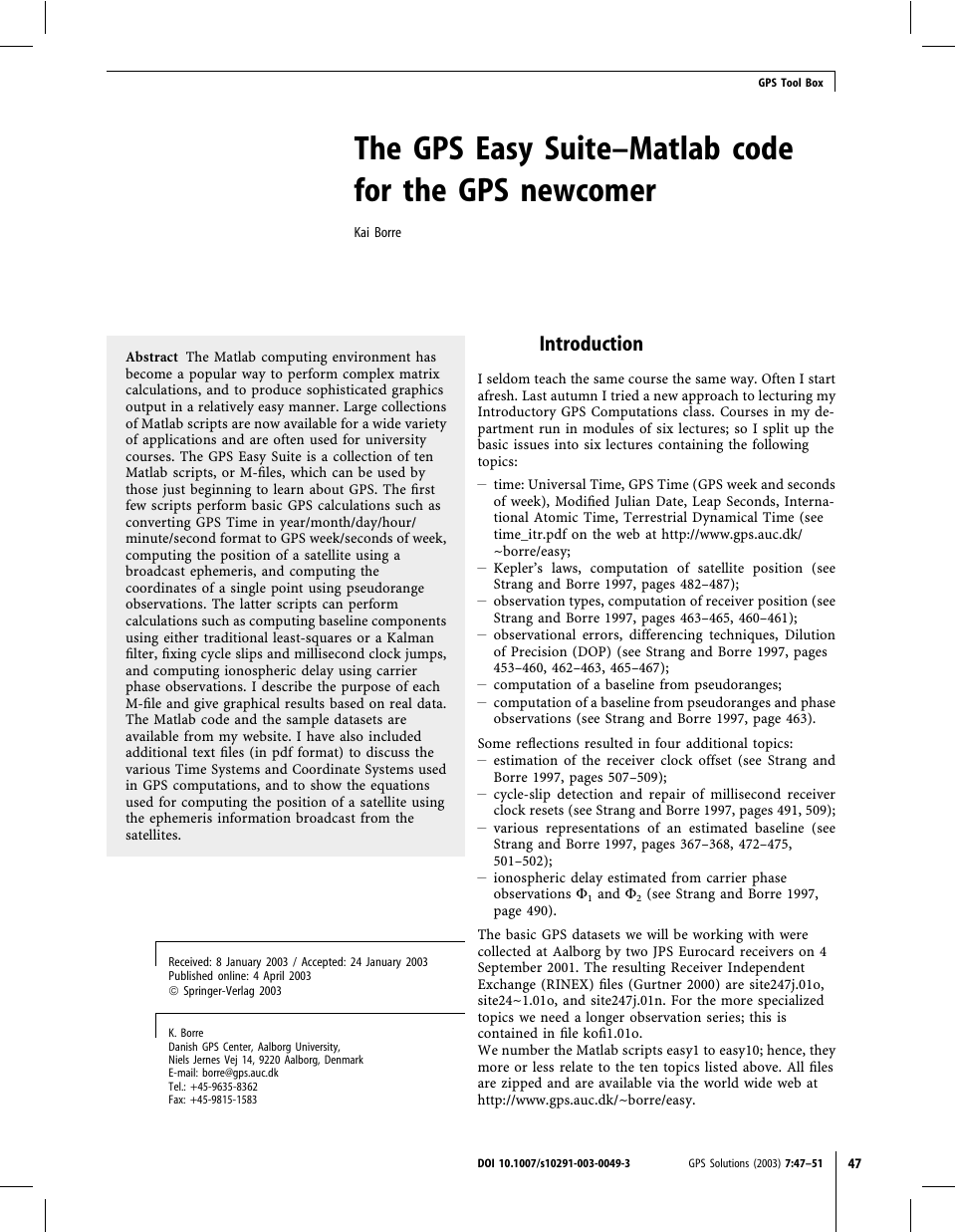
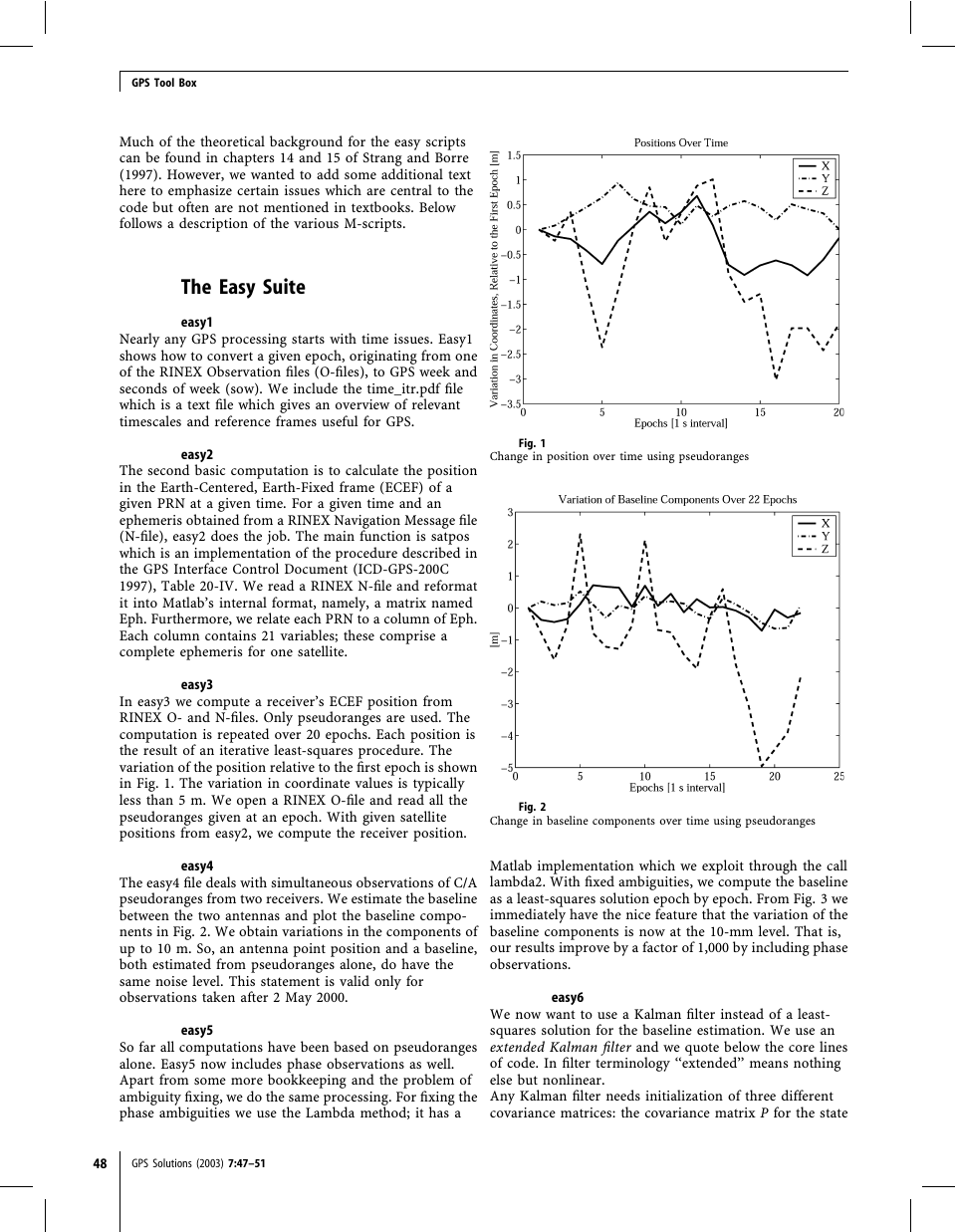
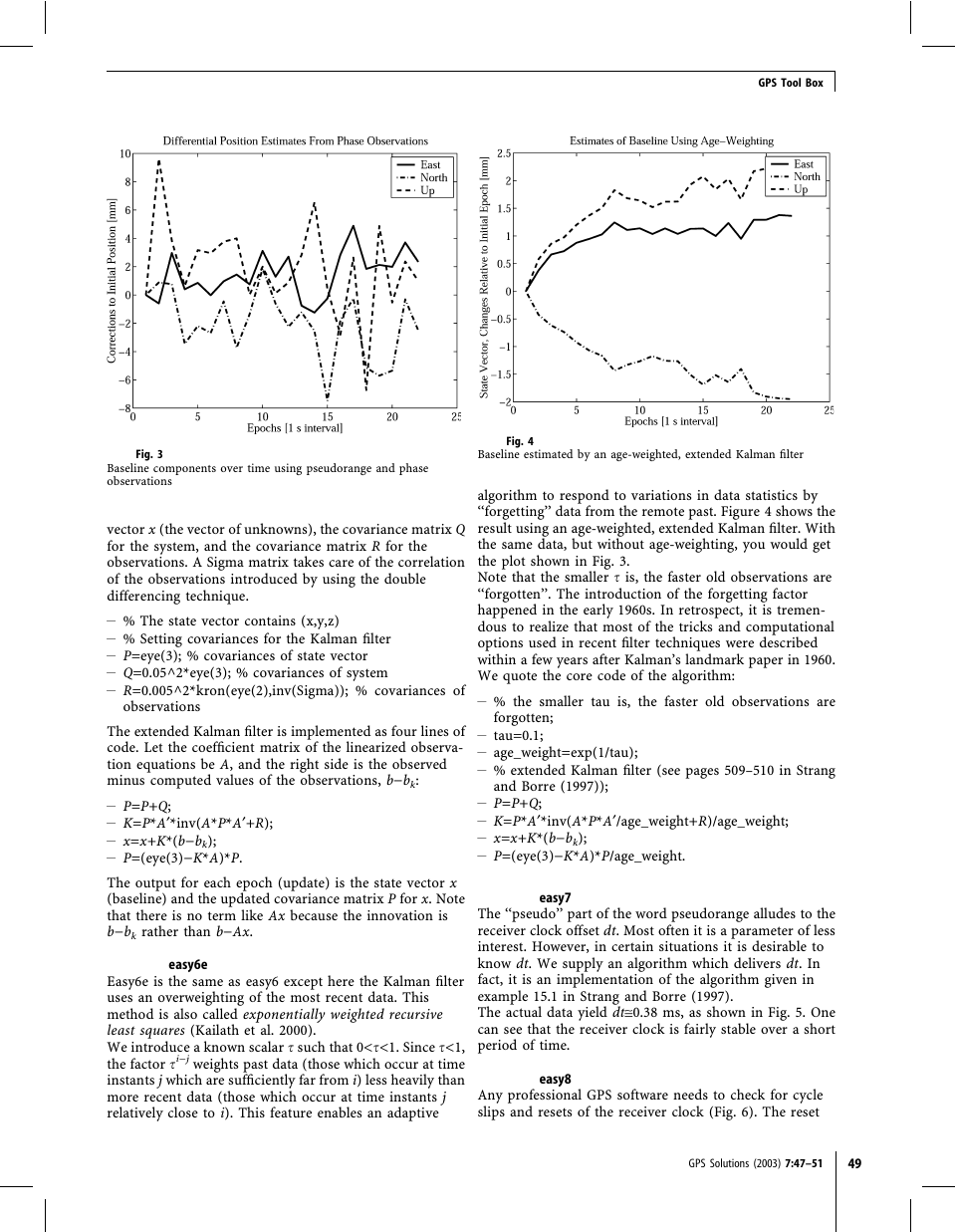
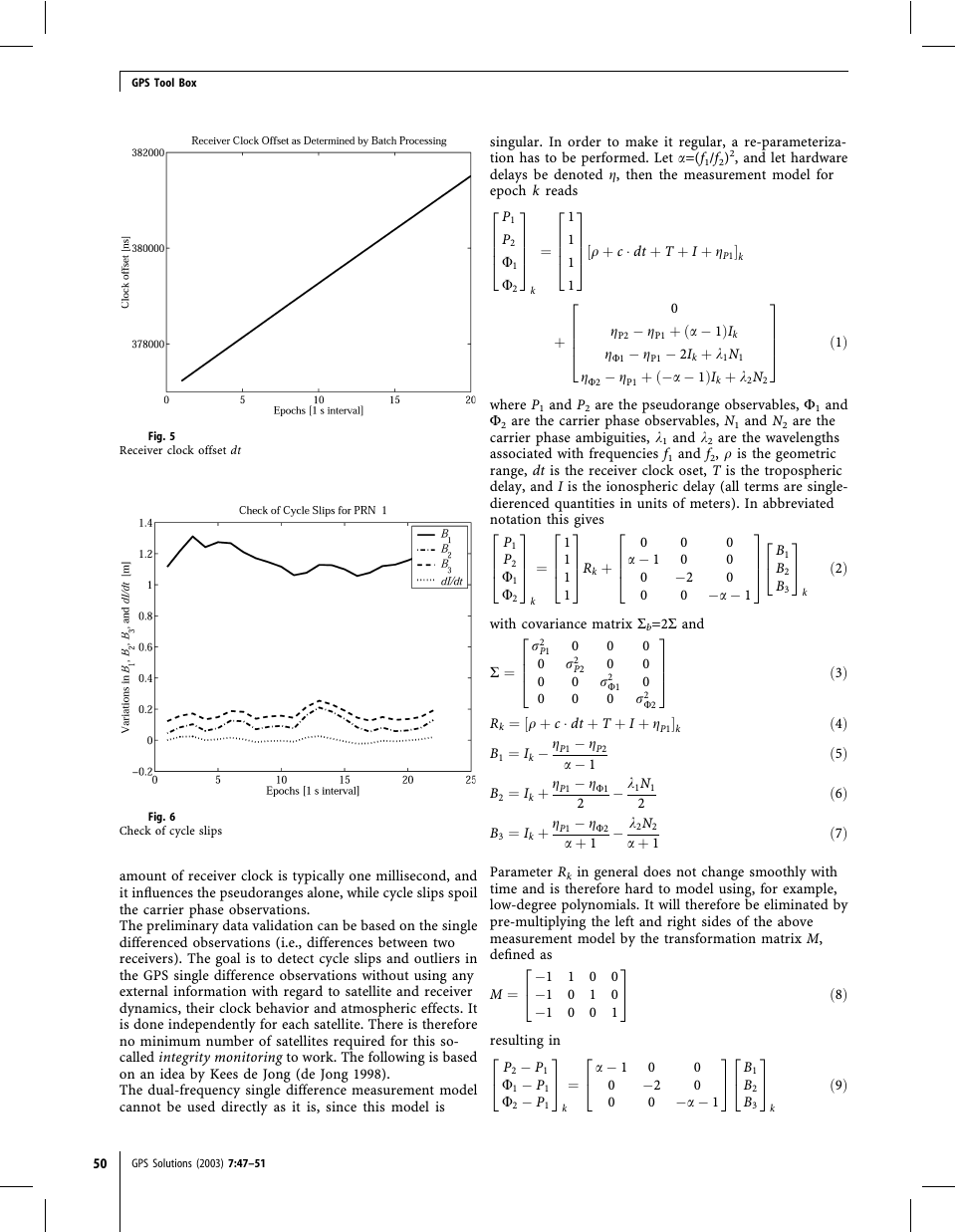
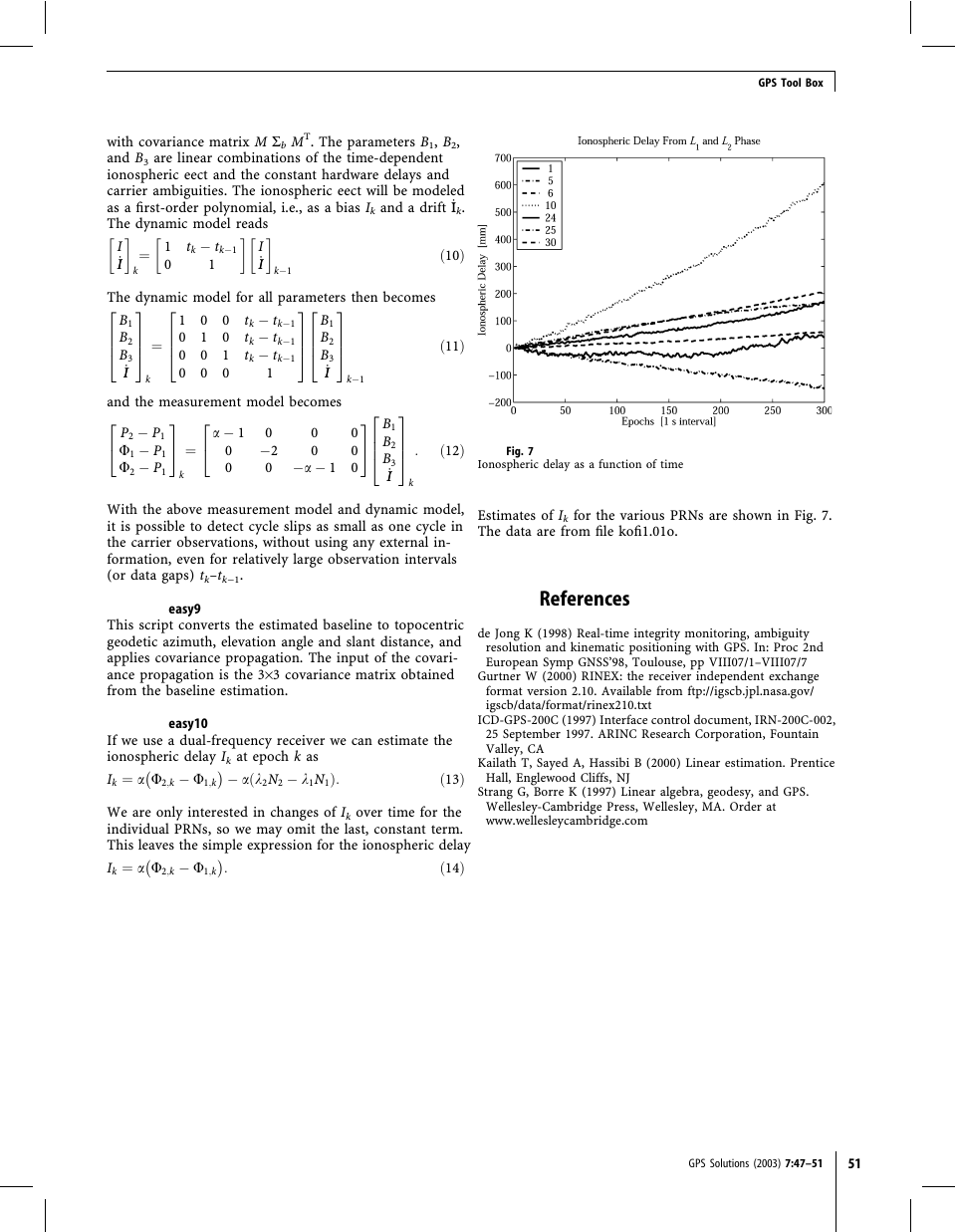





 2023年江西萍乡中考道德与法治真题及答案.doc
2023年江西萍乡中考道德与法治真题及答案.doc 2012年重庆南川中考生物真题及答案.doc
2012年重庆南川中考生物真题及答案.doc 2013年江西师范大学地理学综合及文艺理论基础考研真题.doc
2013年江西师范大学地理学综合及文艺理论基础考研真题.doc 2020年四川甘孜小升初语文真题及答案I卷.doc
2020年四川甘孜小升初语文真题及答案I卷.doc 2020年注册岩土工程师专业基础考试真题及答案.doc
2020年注册岩土工程师专业基础考试真题及答案.doc 2023-2024学年福建省厦门市九年级上学期数学月考试题及答案.doc
2023-2024学年福建省厦门市九年级上学期数学月考试题及答案.doc 2021-2022学年辽宁省沈阳市大东区九年级上学期语文期末试题及答案.doc
2021-2022学年辽宁省沈阳市大东区九年级上学期语文期末试题及答案.doc 2022-2023学年北京东城区初三第一学期物理期末试卷及答案.doc
2022-2023学年北京东城区初三第一学期物理期末试卷及答案.doc 2018上半年江西教师资格初中地理学科知识与教学能力真题及答案.doc
2018上半年江西教师资格初中地理学科知识与教学能力真题及答案.doc 2012年河北国家公务员申论考试真题及答案-省级.doc
2012年河北国家公务员申论考试真题及答案-省级.doc 2020-2021学年江苏省扬州市江都区邵樊片九年级上学期数学第一次质量检测试题及答案.doc
2020-2021学年江苏省扬州市江都区邵樊片九年级上学期数学第一次质量检测试题及答案.doc 2022下半年黑龙江教师资格证中学综合素质真题及答案.doc
2022下半年黑龙江教师资格证中学综合素质真题及答案.doc